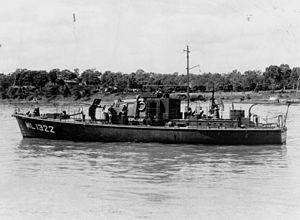Harbour Defence Motor Launch

ML 1322, an Australian HDML, at Brisbane in 1944
|
|
| Class overview | |
|---|---|
| Name: | Harbour defence motor launch (HDML) |
| Completed: | 486 |
| Active: | Until the early 1970s |
| General characteristics | |
| Displacement: | 54 tons (full load displacement) |
| Length: | 72 ft (22 m) |
| Beam: | 16 ft (4.9 m) |
| Draught: | 5 ft (1.5 m) |
| Installed power: | 152 bhp (113 kW) each engine |
| Propulsion: | Twin handed Gardner 8L3 marine engines |
| Speed: | 12.5 knots (23.2 km/h; 14.4 mph) |
| Range: | 2,000 mi (1,700 nmi; 3,200 km) at 10 knots (19 km/h; 12 mph)(1,650 gallons) |
| Complement: | 2 officers, 2 petty officers and 8 ratings |
| Armament: | Typically twin 20mm Oerlikons, twin Vickers K machine guns and six depth charges |
The harbour defence motor launch (HDML) was a British small motor vessel of the Second World War.
The HDML was designed by W J Holt at the Admiralty in early 1939. During the war, 464 HDMLs were constructed, mainly by yacht builders, in the United Kingdom and a number of other allied countries. In view of their later expanded combat roles in some Commonwealth navies some HDMLs were re-designated as "seaward defence motor launches" (SDML) or "seaward defence boats" (SDB).
HDMLs had a round bilge heavy displacement hull 72 feet (22 m) long with a beam of 16 feet (4.9 m) and a loaded draught of 5 feet (1.5 m). Loaded displacement was 54 tons. The hull had a pronounced flare forward to throw the bow wave clear and provided considerable lift to prevent all but the heaviest seas from coming aboard. Although seaworthy, the boat had a considerable tendency to roll, especially when taking seas at anything other than directly ahead or astern. The cause was the round bilge midship section and a considerable reserve of stability, the effect of which was to impart a powerful righting moment if the boat was pushed over in a seaway. This, coupled with the round bilged hull and lack of bilge keels, would set up a rapid and violent rolling.
One of the design criteria was that the boat had to be capable of turning inside the turning circle of a submerged submarine. To achieve this, HDMLs were fitted with two very large rudders and, to reduce resistance to turning, the keel ended 13 ft (4.0 m) before the stern. A side effect of this was that the boat lacked directional stability and was extremely difficult to hold on a straight course.
The hull was of round bilge wooden construction, planked with two diagonally opposed skins with a layer of oiled calico between them – known as a “double-diagonal” technique. The hull was completed with frames or “timbers” riveted perpendicularly from the keel to the gunwale on the inside of the planking, forming a very strong hull. The hull was further strengthened by the addition of longitudinal stringers riveted inside the timbers together with further timbers, known as "web frames". They were fastened inside the stringers opposite every third main timber. HDMLs were fitted with a deeper section rubbing strake aft. Its purpose was to roll depth charges (kept in and delivered from racks on the side decks) clear of the hull and propellers.
...
Wikipedia
